पिछले आर्टिकल में हम पढ़ चुके हैं की rectifier क्या है, और यह कितने प्रकार के होते हैं. Half-wave rectifier की तरह, full-wave rectifier भी डायोड की एक application है.
यह alternating current की positive और negative दोनों cycles को pulsating DC (Direct Current) में बदलता है. जबकि, half-wave rectifier, किसी एक cycle (positive या negative) को pulsating DC में बदलता है. हिंदी भाषा में, Full Wave Rectifier को पूर्ण-तरंग दिष्टकारी भी कहते हैं.
यदि आपको परिभाषा से समझ नहीं आ रहा है की pulsating DC क्या है, या positive और negative cycle क्या है? तो निचे दिये चित्र को देखें।
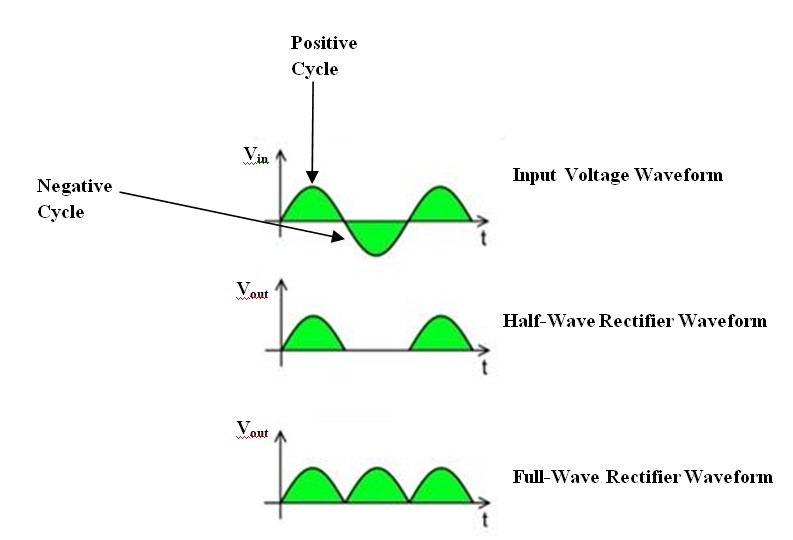
क्या, आप लोगो के दिमाग में भी प्रश्न उठ रहा है, आखिर, हाफ-वेव रेक्टिफिएर में क्या कमी थी, या क्या दिक्कत थी, जो फुल-वेव रेक्टिफिएर को बनाने की जरूरत पड़ी?
इन्हें भी पढ़ें: N-Type Aur P-Type Semiconductor in Hindi
जैसा की हम सभी जानते हैं की Half-wave rectifier में केवल एक diode का प्रयोग किया जाता है. जो या तो positive half-cycle को pass करता है, या negative half-cycle. अब ऐसे में ज्यादा power का wastage होता है.
Also Read: What is Intrinsic Semiconductor in Hindi
दूसरा, यह की half-wave rectifier की waveform में ripples ज्यादा होते हैं. जबकि, full-wave rectifier में ripples कम होते हैं, जिसकी वजह से output waveform काफी smooth यानी clean होती है.
Full-wave rectifier, धनात्मक (positive) और ऋणात्मक (negative) half cycle को pulsating dc में बदलता है. उम्मीद है की आपको समझ आ गया होगा की, full wave rectifier kya hai?
पूर्ण-तरंग दिष्टकारी कितने प्रकार के होते हैं? | What are the Types of Full Wave Rectifiers in Hindi?
यह दो प्रकार के होते हैं,
- Centre-tapped Full Wave Rectifier in Hindi
- Bridge Rectifier in Hindi
(1) Centre tapped Full Wave Rectifier in Hindi
इस rectifier में एक transformer होता है. जिसमें एक छोटा-सा change यानी बदलाव किया गया है. ट्रांसफार्मर की secondary winding के बिल्कुल बीचो-बीच में एक wire connect होता है. जो की ac signal के zero volt पर होता है. इस wire को ही center tap कहते हैं. नीचे चित्र में देखें,
Also Read: Zener Diode in Hindi
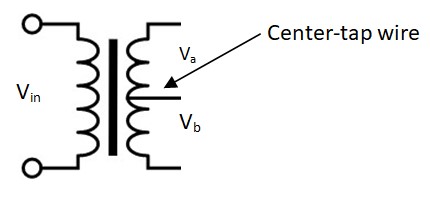
यह wire, वोल्टेज को दो equal और opposite voltage ( Va और Vb ) में divide करता है. Total output Voltage (V) = Va + Vb
ये दोनों voltages ( Va और Vb ), magnitude में equal होती हैं, लेकिन, direction में opposite होती है.

Center-Tapped Full-Wave Rectifier किसे कहते हैं? | Working of Center-tapped Full-Wave Rectifier in Hindi
जब इनपुट वोल्टेज की positive half-cycle apply की जाती है, तब ट्रांसफार्मर की secondary winding का सिरा A, positive और सिरा B, negative हो जाता है. जिसकी वजह से, डायोड D1 को positive voltage प्राप्त होती है, तब वह forward biased हो जाता है. फलस्वरूप, धारा यानी current flow करने लगती है.
Also Read: LED kya hai aur Kaise Kaam Karti Hai?
लेकिन, वही जब नेगेटिव half-cycle apply की जाती है. तब सिरा A, negative और सिरा B positive हो जाता है. फलस्वरूप, Diode D1 reverse bias और Diode D2 Forward bias हो जाता है, और हमे जो करंट प्राप्त होती है, वह डायोड D2 के across प्राप्त होती है.
(2) Bridge Rectifier क्या है? | What is Full Wave Bridge Rectifier in Hindi?
Center-tap Rectifier का एक disadvantage है और वह यह की center-tapped transformer के कारण, इसका cost काफी ज्यादा होता है. इस cost को कम करने के लिए, reserachers द्वारा एक नया transformer design किया गया. वह है, bridge rectifier.
ब्रिज रेक्टिफिएर की rectification efficiency, center-tap rectifier के similar होती है. यह एक ऐसा रेक्टिफायर है, जिसमें 4 diodes का प्रयोग किया गया है, जो alternating current (ac) को pulsating direct current (dc) में बदलता है.
ब्रिज रेक्टिफायर कैसे काम करता है? | Working of Bridge Rectifier in Hindi
जब ब्रिज रेक्टिफिएर पर इनपुट ac signal apply किया जाता है. तब ac signal की धनात्मक साइकिल (positive half-cycle), डायोड D1 और D3 को forward bias करती है, जिसकी वजह से current flow करती है, और डायोड D2 और D4 को reverse bias करती है, जब डायोड reverse bias होता है. तब diode एक open switch की तरह काम करता है, और करंट flow नहीं करती है.

वहीं, दूसरी तरफ जब ऋणात्मक साइकिल (negative cycle) apply की जाती है. तब डायोड D1 और D3 reverse bias हो जाते हैं, और धारा (current) flow नहीं करती है, और डायोड D2 और D4 forward bias हो जाते हैं. हम जानते हैं की Forward bias condition में diode एक closed switch की तरह behave करता है, और हमें load resistor RL के across current मिलती है.
Characteristics of Full Wave Rectifier
अब तक हमने center-tap और bridge rectifier के बारे में पढ़ा. अब हम इनकी characterstics के बारे में बारे में समझेंगे। चलिए, शुरू करते हैं,
(1) Peak Inverse Voltage (PIV)
Reverse Bias Condition में, यह, वह maximum voltage होती है, जिस पर कोई डायोड अच्छे से काम करता है. जब यह वोल्टेज, PIV से अधिक हो जाती है, तो diode के destroy होने की सम्भावना बढ़ जाती है. इसे Peak reverse voltage भी कहते हैं.
PIV = 2 Vmax
(2) DC Output Current
हमने अभी जब ऊपर, full wave rectifier की working समझी थी, तो उसमें हमें आउटपुट Load resistor (RL ) के across मिल रहा था. जो की डायोड D1 और Diode D2 की waveform का sum होता है. डायोड D1 और D2 से प्राप्त current Imax / π .
यानी आउटपुट करंट = Imax / π + Imax / π = 2 Imax / π.
जहाँ, Imax = RL resistor के across maximum DC current है.
(3) DC Output Voltage
यह वोल्टेज, load resistor RL के across प्राप्त होती है. इसे Vdc से represent करते हैं.
Vdc = 2 Vmax / π.
जहाँ, Vmax = maximum secondary voltage
(4) RMS (Root Mean Square) Value of Current
आप current यानी धारा की rms value को नीचे लिखे गये फॉर्मूले से कैलकुलेट कर सकते हैं,
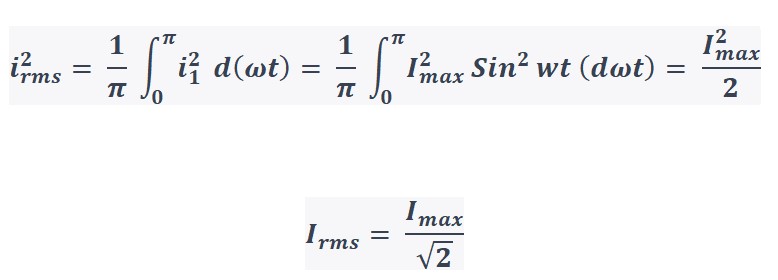
(5) RMS (Root Mean Square) value of Voltage
आप output voltage की rms value को नीचे लिखे गए सूत्र (Formula) से calculate कर सकते हैं,

(6) Form Factor
Current की RMS value और DC आउटपुट करंट के अनुपात (ratio) को Form Factor कहते हैं. इसे Kf से represent करते हैं.
Form Factor = Irms / Idc
(7) Peak Factor
करंट की अधिकतम (maximum) वैल्यू (Imax ) और करंट की rms value के अनुपात (ratio) को Peak Factor कहते हैं. इसे Kp से represent करते हैं.
Peak Factor = Peak Value / RMS Value
(8) Ripple Factor
Ripple Factor, का प्रयोग प्राप्त आउटपुट में ripples check करने के लिये किया जाता है. यदि ripple factor ज्यादा है, तो इसका मतलब यह है की output में प्राप्त DC pulsating signal में ripples ज्यादा हैं और यदि ripple factor low है, तो इसका अर्थ है की ripples कम हैं.
रिप्पल फैक्टर, रिप्पल वोल्टेज और DC वोल्टेज का ratio होता है.
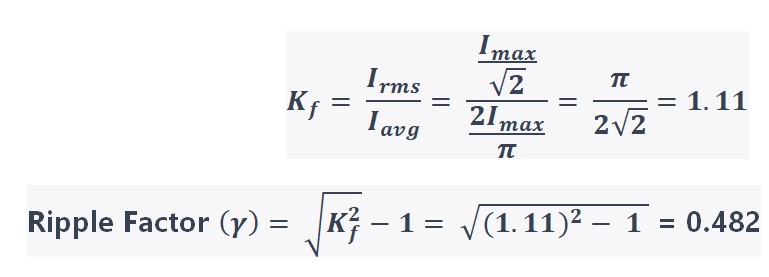
Ripple factor का मान (Ƴ) = 0.48 होता है.
(9) Rectification Efficiency
इस parameter से यह पता चलता है की कोई rectifier किसी alteranating current को direct current में कितने अच्छे तरीके से बदलता है. Rectification Efficiency का मान जितना ज्यादा होगा, वह rectifier उतना ही अच्छे तरीके से काम करता है.
Rectifier Efficiency, DC output power और AC input power का ratio होता है. इसे (Ƞ) से प्रदर्शित किया जाता है. Full Wave-rectifier की rectification efficiency 81.2% होती है. जो की half-wave rectifier की दुगुनी होती है. इसीलिए, full wave rectifier, half-wave rectifier के comparison में ज्यादा efficient होता है.
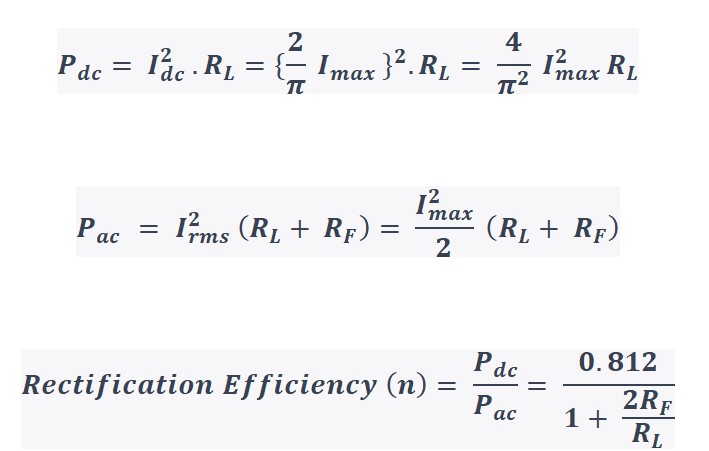
फुल-वेव और हाफ-वेव रेक्टिफायर में क्या अंतर है? | What is the Difference Between Full-Wave and Half-Wave Rectifiers in Hindi?
(1) Half-wave rectifier के मुकाबले Full-wave rectifier में ripples कम होती हैं.
(2) Full-wave rectifier की rectification efficiency, half-wave rectifier से ज्यादा होती है.
(3) क्योंकि, हाफ-वेव रेक्टिफिएर में, ac-input signal की half-cycle को diode, pass करता है, और बाकि की आधी-साइकिल को block करता है. जिसके कारण power waste होती है. जबकि, full-wave rectifier में, दोनों positive और negative half cycle pass होती है, तो output dc power, input ac power के बराबर होती है.
Disadvantages of Full-Wave Rectifier in Hindi
(1) क्योंकि, half-wave और center-tap rectifier के comparison में फुल-वेव रेक्टिफिएर, देखने में ज्यादा complex लगता है, क्योंकि, इसमें 4-diodes का उपयोग किया जाता है.
(2) Full-Wave Rectifier में center-tap rectifier की तुलना में ज्यादा power-loss होता है. क्योंकि, जितने ज्यादा diode होंगे, उतना ही अधिक voltage-drop होगा।
Half-Wave Rectifier या Center-tap full wave rectifier में एक समय पर, एक ही diode conduct होता है. तो, उस समय circuit का drop ०.7 वोल्ट होता है. लेकिन, वहीं bridge-rectifier में, एक समय पर 2-diodes प्रयोग किये जाते हैं, जिनका कुल वोल्टेज drop (0.7 + 0.7 = 1.4 V) होता है.
